Stargazer's World
A Roleplaying Games blog

A look at the Traveller Core Rulebook Update 2022
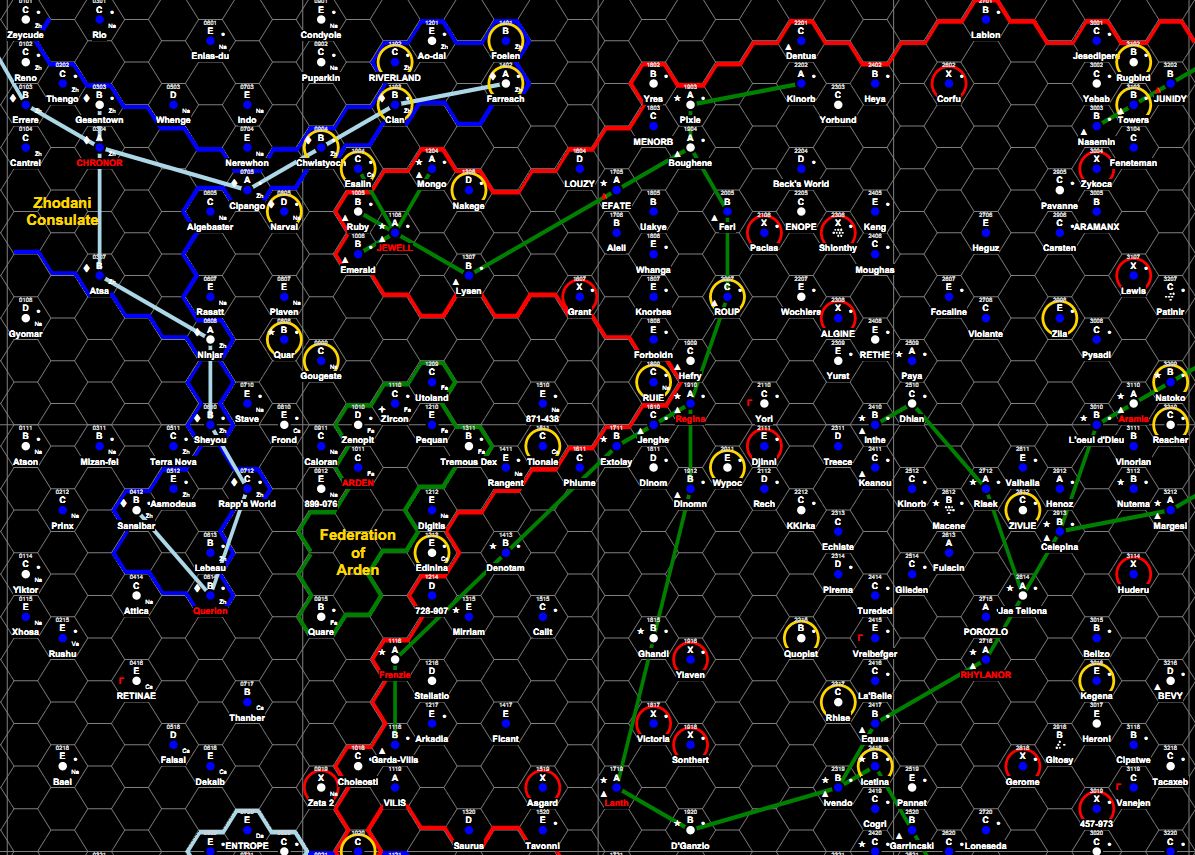
When I first read about Mongoose Publishing releasing a rather expensive update to their Traveller 2nd Edition core rulebook I expected a cash grab. Over the years I have often criticised Mongoose for over-priced products with questionable quality. Especially the editing was often bad to non-existent. But I have to admit that their second edition of Traveller products were actually an improvement. I really liked the modernized layout and higher production values, even though some of the artwork was really, really bad.

Another reason why I haven’t bought anything in a while from Mongoose was their treatment of third party publishers during the transition from 1st Edition to 2nd Edition of their Traveller line. This combined with the questionable quality of their products lead to me avoiding them for quite some time.
Even after all this I was still slightly intrigued when the new corebook was announced. The improved layout looked like a good start and the fact that this corebook included starship generation rules made me think that just maybe Mongoose had learned a lesson. Eventually I made up my mind and ordered a print copy from Mongoose Publishing directly. Why? Because it’s the best deal available. You get the hardcover book plus the PDF for £45 plus shipping, which is totally fine.
After ordering I expected to get access to the PDF at once, but unfortunately that wasn’t the case. My PayPal transaction was still on hold, so I reached out to Mongoose. Interestingly enough, you have to email Mongoose’s owner Matthew Sprange directly and to my surprise he responded pretty quickly and immediately made the PDF available to me. That is actually pretty good customer support especially if you consider that at this point I haven’t even paid the guy. The transaction was still on hold until they were ready to ship the hardcover book a few days later.
To my surprise the book came directly from Studio2Publishing in the US which Mongoose obviously cooperates with. The about 260-paged hardcover book is well bound and looks a lot better than the original 2E corebook from a few years ago. I’ve included a couple images from the book below.

Content-wise not that much has changed from the older version of the rules with the big exception being that they included starship generation this time. I assume that all the errata has been included but – to be honest – I haven’t actually checked yet. At a first glance bad editing doesn’t seem to be an issue this time. There are still a few pieces of art that don’t look that great but overall the quality is in my opinion much better.
One thing which might put off old-school Traveller fans is that everything looks modernized – gone is the retro-SF charm older editions of Traveller had. Personally I don’t mind. At this moment I am much more interested in using Traveller to springboard my own ideas than using it for a traditional Third Imperium game. Given my recent track record I guess I won’t get any game off the ground, but that’s another matter…
Would I recommend anyone getting this book? That depends. If you already own their last core rulebook and are happy with it, there’s not much reason to get the new one. Sure, the art is nicer and the layout is more readable, but overall the mechanics are the same. The addition of the starship creation rules is a nice tough, but at this point most Traveller fans probably already own a copy of High Guard anyway.
If you are new to Traveller, I highly recommend getting this book. It contains everything you need to start playing and it’s a clear improvement over their older rulebooks. Everything else from the 2E line should also be still fully compatible although I guess in the future they’ll eventually update a couple of other books as well.
To my total surprise I really like what Mongoose did with this new book and I wish they had done so from the start. I am still a bit cautious because of their track record, but overall I am looking forward to where things are going. Even though I have a few ideas for campaign settings I am still tempted to check out their new line of 2300AD products, which got a similar update as well.
By the way, alongside with the new core rules Mongoose recently released Traveller: Explorer’s Edition for $1 (or your local equivalent). This PDF (there will be a printed version for £15 later this year) contains all the rules needed to play plus sector generations. I think they also didn’t include all the careers so it’s no full replacement for the core rules, but it’s great if you want to get your feet wet.
I really wish Mongoose Publishing all the best with this new line of products and hope that they’ll not repeat some of the mistakes of the past. It would be a welcome change being able to wholeheartedly recommend their products in the future. The Traveller Core Rulebook Update 2022 is a great start!
Tags: featured
Michael Wolf is a German games designer and enthusiast best known for his English language role-playing games blog, Stargazer's World, and for creating the free rules-light medieval fantasy adventure game Warrior, Rogue & Mage. He has also worked as an English translator on the German-language Dungeonslayers role-playing game and was part of its editorial team. In addition to his work on Warrior, Rogue & Mage and Dungeonslayers, he has created several self-published games and also performed layout services and published other independent role-playing games such as A Wanderer's Romance, Badass, and the Wyrm System derivative Resolute, Adventurer & Genius, all released through his imprint Stargazer Games. Professionally, he works as a video technician and information technologies specialist. Stargazer's World was started by Michael in August 2008.
- Next We finally killed Strahd!
- Previous Upcoming Kickstarter: Into The Odd Remastered
You may also like...
Some thoughts on paizo’s new licenses, what about the complete advanced feats a review…, 2 responses.
- Pingbacks 0
Thanks for the review. I’ve been debating whether to get this since I already have the 2e book and (as you suspected) the High Guard book. I have to admit I was put off by the fact that they didn’t freely offer this as at least a digital update to those of us who already had the pdf. But I know now that I don’t need it, so there’s that.
You’re most welcome.
Leave a Reply Cancel reply
Your email address will not be published. Required fields are marked *
This site uses Akismet to reduce spam. Learn how your comment data is processed .

Follow along with the video below to see how to install our site as a web app on your home screen.
Note: This feature may not be available in some browsers.
- Main category
- Open RPG Discussion
[Traveller] Review: Mongoose Traveller 2nd Edition Core Rules
- Thread starter Dom
- Start date Feb 19, 2018
Administrator
- Feb 19, 2018
TL;DR: Click to expand...
The new edition of Mongoose Traveller has vastly improved layout, artwork and coherent streamlined rules that remain compatible with previous editions. The proofreading and quality of the book is a step change from Mongoose’s previous output. There are two areas that stand out as missing - the starship design sequence (covered in the new edition of High Guard) and an index - but these are not significant issues. If you have the old edition, you do not need to upgrade, but it is a very nice package. Overall, I recommend this new edition wholeheartedly. Click to expand...
- Much of the content is the same, but the three pages of the first edition chapter include an example of play which hasn’t made it over to the new edition.
- There’s no rule zero element either.
- They both achieve much the same, the difference in length being driven by a larger typeface and two half page illustrations in the latest release.
- Overall, the section has grown by 7 pages.
- In characteristics Intelligence is now called Intellect but serves the same purpose.
- Character generation is now presented as a flow chart rather than a checklist; I find both useful reference styles but the flowchart has the benefit of referencing the relevant pages to look at.
- The Background Skills list is now broad (with only the suggestion that you pick something appropriate to your homeworld) whereas it previously had a tie to planetary trade codes.
- Advocate, Comms, Computer, Engineer, Trade and Zero G have all disappeared from the skills listed for this section in 2008; see next section for comments on these changes.
- The character example has changed from Alexander Lascelles Jamison to Dzaeth Dar, a Vargr Pilot.
- Pre-career education (University and Academies) has been added.
- Specialisms are now called Assignments.
- Entertainer gains an option for Dex to be the governing characteristic during the qualification roll, but otherwise the requirements seem to be the same.
- Layout much clearer (and career pages very distinct white on black) and no longer have the tables competing and overlaid with the artwork.
- Other benefits lose Air/Raft (replaced with Personal Vehicle), and Corsair is removed from list.
- Ship Shares now represent MCr1 rather than 1% of the ship’s value (although I’ve just noted that the table for 1% value in the 2008 version is broken).
- Optional Maximum Terms rule is not mentioned.
- Anagathics now need a SOC 10+ roll to be available, with a risk of prison on a fail.
- The older rules have a fully expanded version of Jamison’s creation, but this is not present in the new rules for Dzaeth Dar.
- The material on Alien’s (traits etc.) has been moved to the Traveller Companion.
- Guidance for generating Droyne, Hivers, the K’Kree and Zhodani is no longer in the book; only the Aslan and Vargr remain.
- The 2016 edition adds the Prisoner as a career type and details on how to deal with it.
- It also has a section on post career education (character skill development) which was previously in the Skills and Tasks section. Progression for skill development has been made significantly slower than the first edition, as each study period taking 8 weeks, and multiple periods being needed to increase a skill. In the first edition, going from Skill 2 to Skill 3 would take 6 weeks training previously, and now it would take a minimum of 3 study periods of 8 weeks (effectively half a year) and three successful average EDU checks. This is more realistic, but a significant change.
- The introduction of bane and boon dice as detailed above - they’re the only fundmental rule change.
- Electronics becomes a cluster of skills and wraps up a whole group of similar skills as specialisms underneath it (Comms, Computers, Remote Operations, Sensors). Implicitly, it also replaces Science - Electronics, but that isn’t stated.
- The other big change is that Battledress and Zero-G both merge into Vacc Suit, and Gun Combat is simplified into less specialisms.
- There are around 25 skills that are significantly changed or re-clustered and a similar number with minor name changes or shifts.
- The section on learning new skills is moved into the Traveller Creation chapter, as discussed earlier.
- Initiative now allows the use of INT as well as DEX (you can be fast or smart)
- Stance simplified (only prone creates a DM, crouching has no effect, and the impact is lower)
- Use of the Leadership Skill to generate Banes/Boons
- There is no separate Thrown Attack roll and the ranged attack task check description assumes Gun Combat should be used, but in reality Athletics - Dexterity needs to be substituted. Thrown weapons aren’t discussed in the chapter at all.
- The rules for Delaying an action have been removed (possibly one of the changes that loses a little from the older edition).
- The discussion of Battlefield Comms and Sensors has been removed. These were more descriptions of how the technology worked rather than game rules.
- The impact of conditions from weather has been removed (I assume as would be addressed through the use of an appropriate Bane or Boon dice).
- Recoil and Heft are no longer used.
- Cover is simplified and no longer applies a DM to be hit. It does provide armour now.
- Diving for Cover from an explosion (now a Blast weapon trait) only provides the armour from the cover type rather than halving the damage.
- Blast damage cannot be dodged.
- There are no rules for firing into combat.
- Range is now on a per-weapon basis rather than abstracted by weapon type.
- The optional rules for knockout blows and random first blood are removed.
- The entire Vehicle Combat section is moved to the Vehicle Chapter.
- Damage in the diseases section has been amended and the DMs shifted to formalised task check difficulties.
- The Poisons section has more formalised difficulties rather than DMs and now has intervals.
- Fatigue is now handled with the bane die rather than a DM.
- Falling damage is simplified (you no longer multiply by the G rating, just reduce or increase the number of dice rolled) but this is not expressed simply. Falling in normal gravity does 1D damage per 2m. Falling in low gravity generates 1D damage per 4m (1D per 2m minus 1D per 4m). Falling in high gravity generates 3D per 4m (although the extra dice is only applied in the last two metres - falling 10m generates 7D, but 12 metres 9D as it is 1D per 2m and 1D per 4m).
- As there is no Zero-G skill any more, skill checks to maintain control in Zero Gravity are defaulting to Athletics - Dexterity and there is no way to avoid the checks in combat.
- Radiation and suffocation covered in this chapter not Starship Operations.
- Exposure to vacuum (explosive decompression) is now treated as a special case under suffocation and causes higher rates of damage and exposure to radiation.
- Extreme weather is now a -1 DM rather than a -1 to -4 DM.
- First Aid treatment used to give double effect if applied with 5 minutes, and single effect if applied within an hour. There was a -2 DM when applying to yourself.
- The Range Bands have shifted slightly vs the earlier edition. This affects the closer distances which have now been aligned with 5, 10, 50 metre increments rather than the older Traveller squares/hexes being 1.5m multiples. There is no random distance table in the older chapter.
- The animals section is heavily amended. The section on Planetary Quirks is not present, Instinct and Pack have been removed. The use of characteristics for animals is removed.
- The Terrain Chart DM Table is removed.
- The Rural Encounter Table and linked Animal Type table is removed, as is the weapons and armour table.
- There are more, updated, creature examples.
- Traits for animals are a new introduction.
- The experience table is new.
- The two pages of sample non-player characters are not present, but are arguably subsumed into the Experience Table.
- Vehicles now have their own chapter.
- Robots and Drones have been removed.
- The information is reorganised and some examples no longer present (and really no longer needed).
- The artwork is full colour and improved in many cases.
- The fundamental difference is that all the vehicle rules have been located to a single location.
- There are minor changes within the rules - for example there is no DM to hit because of vehicle size, and the rules clarify that passengers in closed vehicles cannot be targeted directly as they cannot be seen.
- The dogfight action is new.
- Damage from collisions is aligned to speed bands rather than kmph.
- The damage mechanic is amended; there is no structure value anymore (only hull) and the CT style damage table to determine hits and then a linked location table has been dropped with critical hits introduced.
- Vehicle equipment options are increased, and there are example vehicle weapons.
- Previously vehicle mounted weapons relied on the appropriate Gun Combat skill, whereas now they are explicitly linked to Heavy Weapons.
- The same example vehicles are present, but the AFV now sports an autocannon rather than a laser turret.
- In the first edition of Mongoose Traveller, this chapter is preceded by one that is called ‘Spacecraft Design’. In the new edition, all the starship construction rules have been removed from the core rules and put into ‘High Guard’. Only one other edition of Traveller - Traveller: The New Era - has had a core ruleset without the starship design rules. It has to be said that there were issues with the way the construction rules integrated between the core book and High Guard in the previous version.
- The new edition is modified so that it uses the critical hit rules from the starship combat section for maintenance issues.
- The formulae to derive the Transit Times are included in the section.
- Remote Operations are included in this section rather than the Equipment Chapter.
- The impact of radiation and suffocation have been moved from this section to the Encounters and Dangers chapter.
- Manoeuvre - order based upon initiative and limited by the thrust of the starship
- Attacks - order based upon initiative
- Other actions - repairs, jumps, launches and more
- There is no overview step-by-step for starship combat to reference quickly.
- The initiative mechanic has changed - skill has more effect upon it.
- Damage Control role amalgamated into the Engineering role (which is also made more generic).
- Missiles can be used at adjacent or close range but are no longer smart.
- Missile Thrust is now 10, not 5.
- The rules for missile attacks have been changed and depend more upon the salvo size.
- Meson guns, particle accelerators, fusion guns and nuclear missiles are not detailed.
- Pulse weapons corrected in line with Traveller canon - originally done in High Guard in the previous edition.
- There is no separate hull and structure values - ships only have hull points now.
- The damage mechanic has moved away from one similar to Classic Traveller and differs between missiles and beam weapons.
- The scaling between starship and ground weapons is different (reduced)
- Dogfighting close combat rules that change the feel of combat and Traveller.
- Gains Type T Patrol Corvette, Safari Ship, Subsidised Liner, Slow Boat, Slow Pinnace
- Loses Corsair, Gazelle Class Close Escort, Heavy Freighter, Serpent Police Cutter
- Buying older ships used to give the characters extra ship shares, but the whole process is now much more simple.
- The ability to get telepathy automatically has been added.
- The range calculation for psionic costs has been simplified so that it is the same for all talents, but it means that there is no longer a quick reference table to look up against. It works by having a default maximum range which can be pushed.
- Telepathy has the Mind Link power (psion-to-psion telepathy) and the Suggestion power added. The latter is new and didn’t appear in Psion.
- Telepathy - Assault Damage mechanic has changed.
- Telekinesis - Flight has a speed added.
- Telekinesis - Telekinetic punch has reduced damage potential (now just effect, not effect + 2D)
- Telekinesis - Pyrokinesis has become significantly easier as the check has moved from Difficult to Routine (a shift of DM +4 between versions).
- Awareness - Body Armour has been renamed ‘Fortitude’. Mechanically, the difficulty has been reduced to Difficult from Very Difficult.
- Awareness - Regeneration has had the difficulty reduced from Difficult to Very Difficult.
- Awareness - Enhanced Awareness has been removed
- Awareness - Inspiration has been added. It serves a similar purpose to Enhanced Awareness but provides a Boon dice to any one check.
- Teleportation has been tweaked to account for the changes in the range mechanic.
- The tables on ‘Alien Horror’ and ‘Psionic Phenomenon’ have been removed.
- Basic passage has been introduced.
- The costs of high, middle and low passages have been changed (increased).
- The number of passengers a point of steward skill can support has been increased.
- Trade code modifications have been removed from affecting passenger numbers and the effect of population and travel zone has been changed.
- A single table is used for number of passengers available with differentiation driven by a DM to the roll.
- Trade code modifications have been removed from affecting the amount of freight lots available and the effect of population and travel zone has been changed.
- A single table is used for number of freight lots available with differentiation driven by a DM to the roll.
- Sidebar describing the Imperial Credit has been removed
- Costs for using a broker have been increased.
- The modified price table has been changed even though the input DMs appear to be the same on the Trade Goods table.
- The Dangerous Cargo sidebar has been removed.
- The Trade Goods by World Type has been removed.
- The diagram showing how a hex is usually formatted has been removed
- The example District Red 27 subsector map has been removed.
- The sidebar on factionalism has been removed but the general information on factions has been increased.
- The law level table for illegal possessions has had the sections on drugs, information, technology, travellers and psionics removed; some of this is now rolled up into summaries in the government table.
- The starport facilities table has lost the roll target numbers for TAS for Class A (4+) and Class B (6+) and the options to generate Imperial Consulates or Pirate bases have been removed.
- The Starport Class table is now modified by the Population Code.
- The sidebar that gives suggestions on how to modify world creation for Space Opera or Hard SF settings has been removed.
- Mar 3, 2018
The British Fantasy Society have been reviewing some of the line too: http://www.britishfantasysociety.org/reviews/traveller-high-and-dry-adventure-rpg-review/ - Neil. (BFS Webmaster)
Crackin' review Grommit
- Mar 4, 2018
This is my set of notes for GMing starship combat as written in the Core book; I've pulled all the cross referencing together into a single flow. If you use it, feel free to comment so I can improve it. https://docs.google.com/document/d/1OKSOLDYFjCMqZDRErJWoNkTW6EX9eDfKRjcOc3WSIk8/edit?usp=sharing
- This site uses cookies to help personalise content, tailor your experience and to keep you logged in if you register. By continuing to use this site, you are consenting to our use of cookies. Accept Learn more...

- Conferences
- ACCU Online
- ACCU 2023 Bristol
- ACCU 2022 Bristol
- ACCU 2021 Online
- ACCU Autumn 2019 Belfast
- ACCU 2019 Bristol
- ACCU 2018 Bristol
- ACCU 2017 Bristol
- ACCU 2016 Bristol
- ACCU 2015 Bristol
- All Conferences
- Journals Overview
- Overload by Issue
- Overload by Article
- Overload by Author
- Overload by Cover
- C Vu by Issue
- C Vu by Article
- C Vu by Author
- C Vu by Cover
- Reviews Overview
- Reviews by Date
- Reviews by Title
- Reviews by Author
- Reviews by Reviewer
- Reviews by Publisher
- Reviews by Rating
- Digests of Old Reviews
- Local Groups
REVIEW - Traveller Core Rule Book - 2nd Edition

Traveller Core Rule Book
2nd Edition
Matthew Sprange
9781908460523
Mongoose Publishing (2016)
Ian Bruntlett
★★★★★
Verdict: Highly recommended
Note: A tabletop RPG (Role Playing Game) is where a GM (Games Master, aka Referee), runs a game, with the key characters (aka the Travellers) being played by the players.
Mongoose launched a new era for the Traveller tabletop Role Playing Game (RPG) in 2008, with the first edition of its core rule book (CRB), as a hardy A4-sized hardback book. This was the first time I ever got my hands on a Traveller book. Printed in black and white, with some art, the first edition of the core rule book was part Universe-agnostic and part Third Imperium of Mankind based. Subsequent books took in other Universes – Babylon 5, 2300AD, Judge Dredd, Strontium Dog, Hammers Slammers – and these were only the tip of the iceberg. Traveller was first published in 1977.
The second edition of this book was published 2016 and saw the introduction of full colour and improved artwork. An index and a glossary would have been helpful – and, to aid rapid access whilst running games, I’ve had to 1) create my own extended contents and 2) paste the tables from the Traveller Referee’s screen to the inside front and covers (useful when running a game in a coffee shop). During the lockdown of 2020, this book completely sold out; but it should be available again now.
The default setting for Traveller games is in the Spinward Marches sector, in proximity to The Third Imperium of Mankind, The Aslan Hierate, The Zhodani Consulate and The Vargr Extents.
There are some assumptions made about the standard Traveller game. The default currency is the Imperial Credit. There is no warp drive – ships travel from one subsector to another, using a Jump drive. This enables faster than light (FTL) travel: where a ship travels beyond the 100-diameter limit of planetary or solar bodies, makes the jump into Jump Space, spends a week in Jump Space and comes out into normal space, one or more parsecs away from their starting point. There are no FTL communications. Solar Systems, as published in the sourcebooks, have a collection of worlds with some rough details, but only the two most interesting settlements are documented. The rest is up to the GM. Worlds are defined using a string of hexadecimal digits called a World Profile which lists Star Port quality, world size, atmosphere type, hydrographic percentage, population, government type, law level and tech level (TL). There is a lot of scope for an ambitious GM to create a unique version of the standard Traveller Universe and still be roughly compatible with sourcebooks and adventure modules based in the Third Imperium. An even more ambitious GM is free to abandon that heritage and create their own, totally unique Universe or even one based on their favourite sci-fi books/films.
On to the book itself. A Traveller game starts off with a group activity – Traveller Creation (Chapter 1). is in its own right a mini-game. Every action in Traveller is skill-based or characteristic-based (Strength, Dexterity, Endurance, Intellect, Education and Social Standing), which are covered in Chapter 2. Combat (Chapter 3) is deadly, complicated to run and best avoided. Encounters and Dangers (Chapter 4) is a mixture of hazards that Travellers are routinely exposed to and mainly of use to a GM. A small selection of available equipment (Chapter 5) is present, which is supplemented by an additional book, the Central Supply Catalogue . Chapter 6, Vehicles similarly presents rules for common vehicles and is supplemented by the Vehicle Handbook . Spacecraft Operations (Chapter 7) covers a mixture of details (power requirements, maintenance, running costs, mortgage costs etc). Chapter 8 is devoted to space combat – deadly, complicated and expensive. Chapter 9 covers common spacecraft and is supplemented by the High Guard core rulebook. Chapter 10, Psionics, is an optional magic system for the system. Trade, Chapter 11 (pun intended?), is all about interstellar trade and is a mini-game in its own right – one of the original authors of Elite was a Traveller fan. Finally, Chapter 12 is all about world creation. Although the book can stand on its own merits, there is also the Traveller Companion , a 166 page compilation of variant and alternate rules. More information can be gleaned from the Journal of the Travellers’ Aid Society Volumes 1-6.
In the Internet based world we live in, support is available. Mongoose’s website is an online store for all of its in print products – out of print products, where licensing permits, are available as PDFs. Mongoose Publishing takes part in the Bits and Mortar scheme where purchasers of their titles gain a free PDF of that title. This is particularly helpful for searching because, until relatively recently, indexes weren’t provided in these books. Their website offers forums ( forum.mongoosepublishing.com ) for the discussion of games and is a good source of help as is the downloads section. Other support websites include the Traveller Map ( travellermap.com ) – possibly the most detailed RPG map ever and The Traveller Wiki ( wiki.travellerrpg.com ), a library and game resource.
As can be expected, Traveller is a game, not a simulation. A GM has to be at least familiar with the contents of this book and be able to ad lib at a moments notice. The books all portray the setting in broad strokes. There is room for customisation and specialisation everywhere.
In Conclusion, Traveller is a more pro-active way to spend leisure time – and Mongoose’s books do it justice.
Website www.mongoosepublishing.com

Advertisement

Copyright (c) 2018-2023 ACCU; all rights reserved.
Template by Bootstrapious .
Ported to Hugo by DevCows .
Customized for ACCU by Jim and Bob.
Hosting provided by Bytemark .
Your Privacy
By clicking "Accept Non-Essential Cookies" you agree ACCU can store non-essential cookies on your device and disclose information in accordance with our Privacy Policy and Cookie Policy .
Current Setting: Non-Essential Cookies REJECTED
By clicking "Include Third Party Content" you agree ACCU can forward your IP address to third-party sites (such as YouTube) to enhance the information presented on this site, and that third-party sites may store cookies on your device.
Current Setting: Third Party Content EXCLUDED
Settings can be changed at any time from the Cookie Policy page.
Username Or Email
Remember Me
Lost Password
Reset Password

- Gaming News
- Comic Books

The Iconic SF RPG Updated: Traveller Core Rulebook (Update 2022) Reviewed
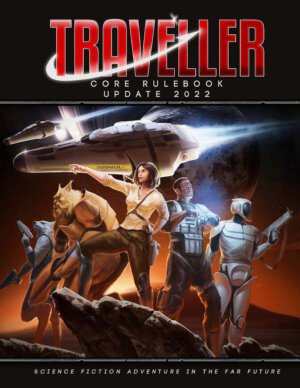
Publisher: Mongoose Publishing
Authors and Designers: Marc Miller (Classic Traveller), Matthew Sprange (Mongoose Traveller Developer), and Gareth Hanrahan (Original Core Mechanics)
Artists: Katrina Hepburn and Sandrine Thirache (Layout), Xavier Bernard, Sergio Villa, Anderson Maia, Mark Graham, Nikita Vasylchuk, Douglas Deri, Ian Stead, Ankit Yadav, Cassie Gregory, Alessandro Rocco, and Colin Dunn
Genre: Classic science fiction roleplaying game
MSRP: $59.99 for the hardcover or $30.00 for the PDF at DriveThruRPG
In many ways, Traveller is to science fiction roleplaying what Dungeons & Dragons is to fantasy roleplaying. First published in 1977, Traveller has been through many editions and publishers in its long history, landing with UK publisher Mongoose Publishing in 2008. A second Mongoose edition came out in 2017, featuring greatly improved art and presentation as well as some revised rules mechanics. This “Update 2022” version keeps the 2nd Edition rules changes and adds some material that was notable absent from the previous corebook notably ship creation rules. I should note that, while I have run and played the 1st edition of Mongoose Traveller, I had not engaged with the 2nd Edition of the game until reviewing this book.
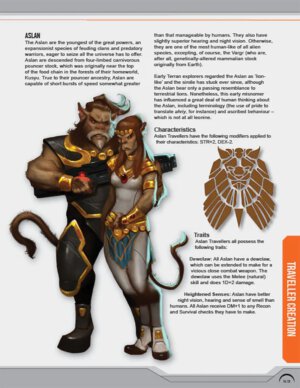
The second iconic element of Traveller is the tech-y, relatively realistic presentation of standard sci-fi elements like ships, travel mechanics, planetary systems, and the like. While the universe does include Faster-Than-Light travel and artificial gravity, the technology is otherwise fairly grounded. Ships have a utilitarian feel to them, and unlike the original 2nd edition core book can be built from scratch (a process that, unlike some previous editions of Traveller, does not require advanced high school math to complete). Moreover, we see several pages worth of Traveller’s iconic 2d deck plans for ships that would be commonly flown by PC groups. There is also a lengthy personal gear and non-starship vehicles. It’s worth noting that Traveller has always avoided wading deep into the “transhumanist” side of sci-fi, and so while there is some cybernetics, there is very limited AI and little in the way of body modification or brain swapping (as compared to something like Eclipse Phase).
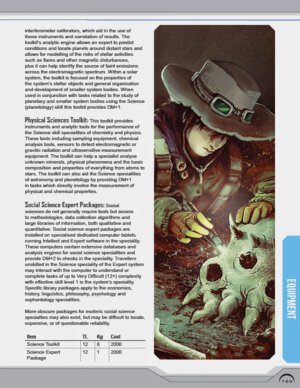
Gameplay-wise, Traveller uses a 2d6 mechanic—roll 2d6, add modifiers for attributes and skills, try to beat a target number (8 by default). Added for the 2nd edition of the game is a “boon and bane” system that is similar to Advantage and Disadvantage in 5e D&D—when circumstances are favorable, roll 3d6 and count the highest two dice; when circumstances are unfavorable roll 3d6 and count the lowest two dice. As with many sci-fi systems, skills are at the core of the system, with a large but not overwhelming skill list. Combat is quick and fairly deadly, with damage coming off of physical attributes. The game engine is simple, plays fast, and should not present too much of a learning curve for new players and GMs coming off of other game systems.
Finally, while the 1st edition of Mongoose Traveller made the dubious choice to go for a retro-1970s look in terms of art and lay-out, Update 2022 has a clean, modern lay-out, with full color art. The art is not at the level of the very top of the industry (i.e. Free League Publishing), but it is solid and pleasant. The book is well-organized, and the PDF I reviewed has bookmarks (although they have very few second level bookmarks, which is disappointing). It’s worth noting that Mongoose’s products in general, and 2nd edition Traveller materials in particular, are a bit on the pricey side for the length of the books and what you get. Still, the Update 2022 Corebook is a beautiful book, and a solid value.
There are a host excellent sci-fi rpgs settings and systems out there, but Traveller has stood the test of time. The Third Imperium setting is one of my favorite sci-fi settings, and this Update 2022 book has got me back into Mongoose’s Traveller line. Traveller is a classic, but it is a classic for a reason, and if you are looking for a grounded sci-fi game with lots of space for the GM and players to explore, it’s hard to go wrong with this product.
- Recent Posts
- The Undead are So Full of Life! Warhammer Age of Sigmar Soulbound: Champions of Death Reviewed - Apr 13, 2023
- That’s a Lotta Swords: Temple of 1000 Swords Reviewed - Apr 8, 2023
Nice review. For old-school Travellers, does the Mongoose edition have advantages or shortcomings relative to the original “little black books”?
Leave a Reply Cancel Reply
Your email address will not be published.

Blade Runner: The Roleplaying Game Case File #2 – Fiery Angels Reviewed
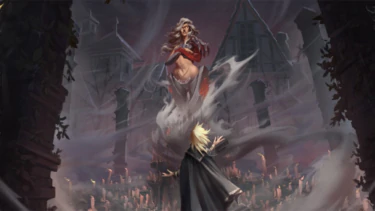
Pathfinder Adventure Path #200: Seven Dooms for Sandpoint Reviewed
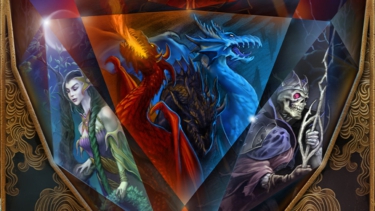
Free 13th Age Second Edition Preview is Available at DriveThruRPG
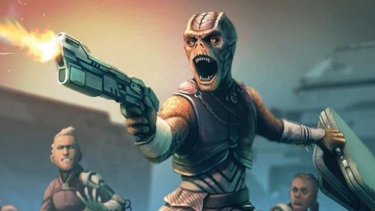
Save Big with The Journal of the Travellers’ Aid Society Bundle of Holding


Related Posts

Clash of Galliformes Board Game Lands May 17th

Curse of the Chupacabra is Out in Print and PDF from The Sagaverse
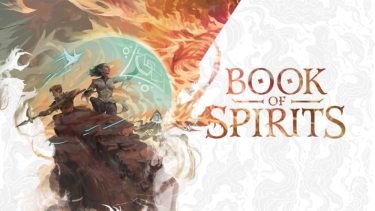
Book of Spirits for 5E Kickstarter Enters Final Week for Beyond the Screen Studio
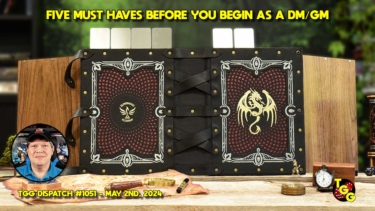
Five MUST HAVES to Get Started as a Dungeon Master/Game Master on The Gaming Gang Dispatch #1051
FREE UK shipping over £100 or over $150 to US
Free PDF with every book purchase
Sign up to our newsletter
Get all the latest information on Events, Sales & Offers. Sign up for newsletter today

- Core Rulebooks
- The Charted Space Universe
- Journal of the Travellers' Aid Society
- Accessories
- Traveller Fiction
- eBook Exclusive
- The All New Shiny Edition
- The Older Stuff
- Shield Maidens
- Sea of Thieves
- Core Rulebooks & Accessories
- Classic Traveller
- Classic JTAS & 3rd Parties
- MegaTraveller
- Traveller: The New Era
- 1E Mongoose Traveller
- 1E Mongoose 2300AD
- Deus Vult Legend
- World of Xoth
- Other Settings
- Slayer's Guides
- Encyclopaedia Arcane
- Quintessentials
- New Classes
- Ultimate OGL Collections
- OGL Core Rulebooks
- Miscellaneous
- Battlefield Evolution
- Release Schedule
- Traveller Licensing
Your cart is empty
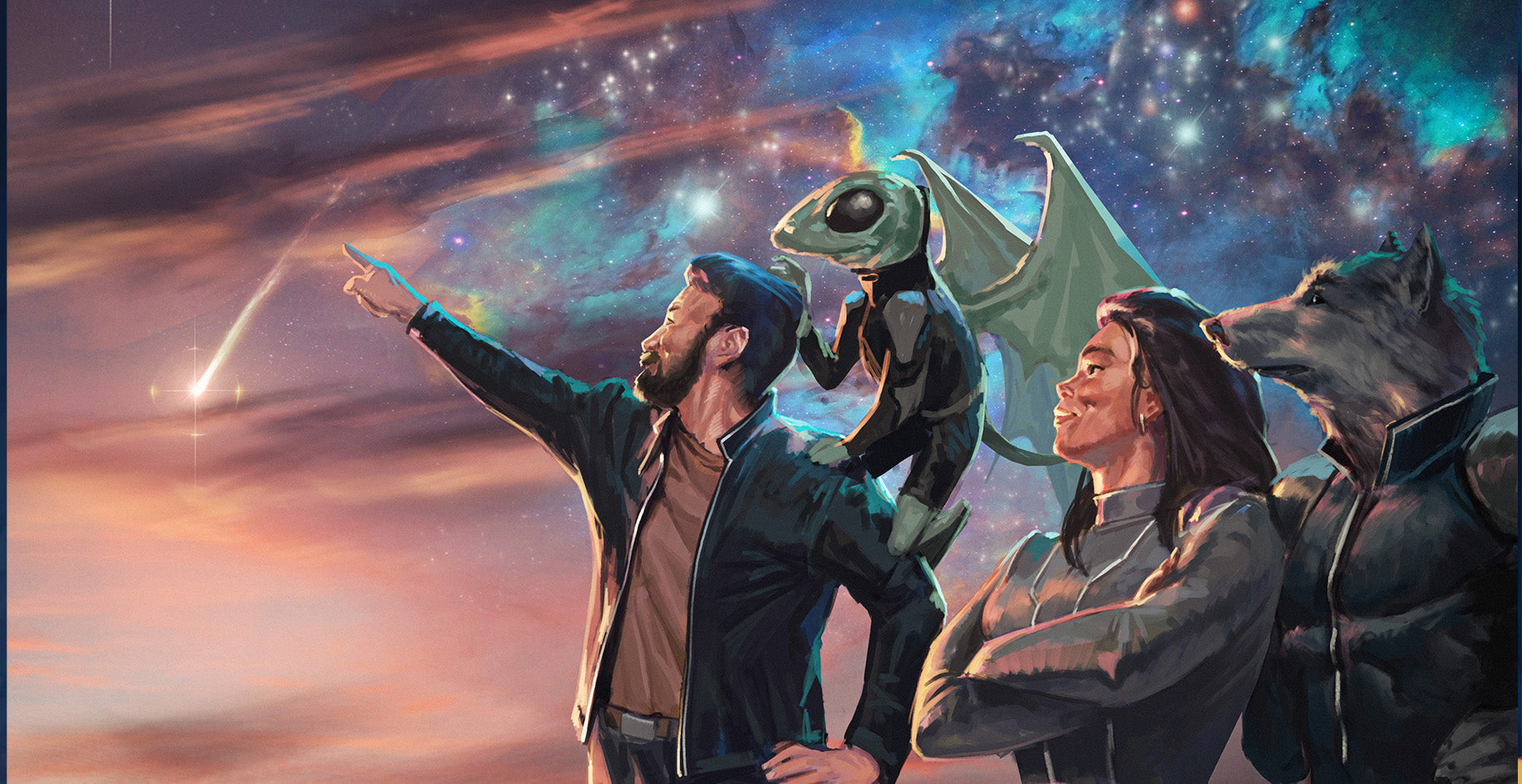
Welcome to the Far Future.
The latest edition of Traveller is based on the original classic but tweaked, finessed and updated for the 21st Century! Every Traveller book is now printed in full colour and all core rulebooks and supplements are gorgeous hardbacks, packed with everything you have come to expect from your favourite science-fiction RPG.
Traveller contains everything needed to play any science-fiction campaign, from desperate battles across the stars against evil empires, through free traders operating on both sides of the law, to mercenary companies desperate to find their next ticket or face bankruptcy - Traveller gives you the tools to explore the universe in a way that suits you.
- Sourcebooks
- Traveller eBooks
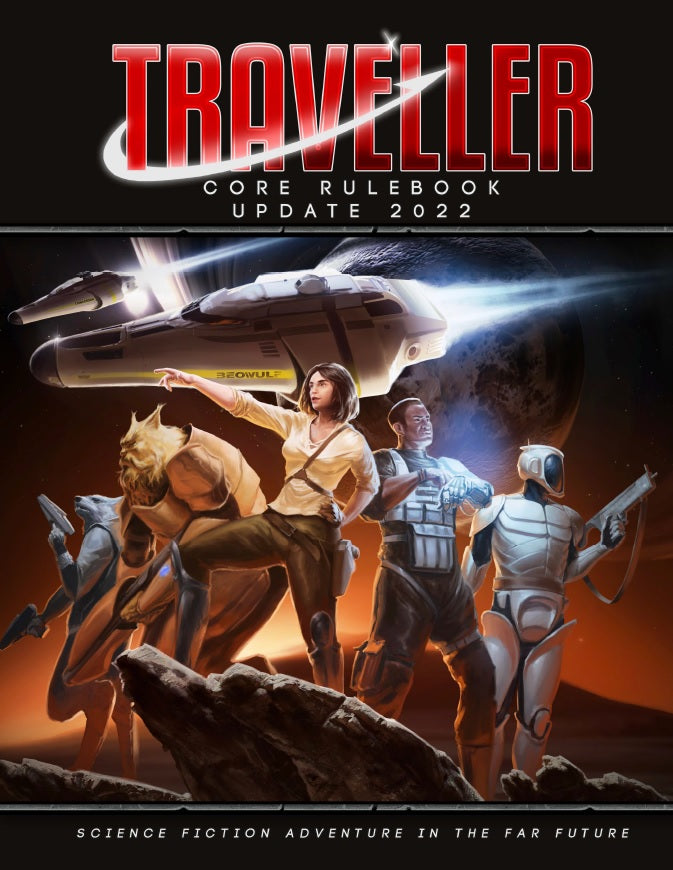
Free shipping
Free UK & US shipping on orders over £100 or $150
With every book purchase get a FREE PDF to download
Secure payment
Your payment information is processed securely.
Need to contact us? Just send us an e-mail at [email protected]
Cookie policy
I agree to the processing of my data in accordance with the conditions set out in the policy of Privacy.

- Witch Queens
- Witch Links
Tuesday, May 3, 2022
Review: classic (basic) traveller.
It's May and I want to spend the entire month talking about Sci-Fi RPGs, and most of this month talking about Traveller . Traveller has a long and storied history in both the RPG world and for me personally. It is the second (or the third, more on that) RPG I ever owned after D&D.
I say second but my memory is foggy and it could have been Traveller or it could have been Chill. I think for my horror cred I like to claim it was Chill, but in the early 80s, I was all about Science Fiction. So really it was most likely to be Traveller. I picked up the Traveller Book and tried to teach to it to myself, but my groups were very D&D focused and no one wanted to play it. The groups that did play it were all older than I was and they did not want some "D&D kid" in their "Serious Sci-Fi" groups. I was able to more traction on Star Frontiers a few years later. Must have been the TSR bias of the time. I do wish I still had my original Traveller Book though. I did manage to score an Original Traveller boxed set of the "Little Black Books" so I guess that is even better.

Today I am going to review Traveller and start at the very beginning. There is just no way I could through everything for Traveller. I'd need more than a month, I'd need a whole new blog, so instead, I was going to going to concentrate on some core products to get people into the game and a few choice ones that have meaning to me.
I will admit right up front that I am no Traveller expert. So it is very, very likely I will miss a few a things. Just let me, and others, know in the comments.
Ok, as my friend Greg said on Sunday, let's get this party started!
Classic Traveller
For this review, I am going to be referring to my 1977 Game Designers' Workshop edition of the boxed set of Traveller. I am also joining to be comparing them the PDFs of the Classic Traveller Facsimile Edition from Game Designers' Workshop / Far Future Enterprises on DriveThruRPG.
Side Note: Far Future Enterprises bought the rights to various GDW games a while back and published this pdf as far back as 2001. They own the rights to republish Traveller, 2300 AD, Twilight: 2000, and Dark Conspiracy. They also work with Mongoose and other publishers of Traveller material. But more on that in future posts. Suffice to say that from my point of view they have been carrying the torch of Traveller high since 2000. Among other things they publish a full CD-ROM of Traveller material that I would love to grab someday.
The Boxed Set
The Traveller Boxed Set from GDW was released in 1977. GDW was located in Normal, IL which is along what I learned was a trail the lead from Lake Geneva, WI, and Chicago, IL all the way down to the University of Illinois in Urbana, IL, Illinois State in Normal, IL down to Southern Illinois Univerity in Carbondale, IL. Tim Kask was an SIU grad, GDW was in Normal, Mayfair would later be founded in Skokie just outside of Chicago, and Judges Guild was founded in Decatur, IL. I basically grew up surrounded by the growing Table Top RPG scene.

Much like Dungeons & Dragons of the time, Traveller came in a digest-sized box with three books. Instead of there being "3 Little Brown Books" there are "3 Little Black Books." Also, like D&D future printings would combine these books though in different ways.
PDF Note: The Classic Traveller Facsimile Edition also includes a preface for the whole set of books and gives a brief history of their publications. This is a great value-add for the PDF. According to it what I am reviewing today is "Basic Traveller" and published in 1981. Basic Revised was published in 1981 and the Traveller Book (my first purchase) was in 1982.
Book 1: Characters and Combat
This is the character generation book and maybe one of the most famous bit of RPG lore ever. Yes. In Traveller you can die in Character creation!

I should also point out that very, very often in my conversations with people over the years that Character Creation for Travelller was very much in line with what we would call "Session 0" today. Everyone worked on their character, developed a back story (yes in 1977) and then got together. Even the starting character example is a 42-year-old with a pension (and a cutlass it seems). Trust me, at 42 I already had backstory (and a wife, kids, a mortgage, bills...)
Character creation is largely a random affair, but not wholly so. There are choices to be made along the way. How a character acquires skills and expertise largely depends on which service they were in and how they got there. You can enlist or you can be drafted. At this point, all characters were assumed to have served in some form of the service. Citizens don't mortgage their pension on a beat second-hand starship to go galavanting across known space.
As you work through character creation you can go for a few terms of service. This gives you more skill, more experience, more credits, and makes you older. As in real life, there are benefits and detriments to age.
Skills are detailed next. This is going to come up again and again, but let's talk about it here first. The Computers of Traveller are the computers of 1977. Not very advanced and require special expertise to use them. Today of course I am writing this post in one window, monitoring email and chat in another, watching the weather in another, and reading the PDF in yet another. I have dozens of active programs running that I am paying attention to and who knows how many more running in the background. I am not going to apply 21st-century biases though to these rules. Let's just leave them as-is for now and see how future versions of this game treat it. For me I am going to assume there are computers (with a lower case c) that do all the work we think of today and anyone can use and then there are specialized Computers (with an upper case C) that do specialized work, like today's supercomputers.
Side Note: The best super-computer of 1977 was the 80mhz, 64 bit Cray-1. It cost $8M and was capable of 160 MFLOPS . For comparison, my three-year-old smartphone runs at 130ghz and is capable of 658 GFLOPS. Newer phones are more than double that. 4000x's the power at 1/10,000th of the cost. And I can put it into my pocket.
After your terms of service are figured out along with your skills then comes the time to learn combat. Combat always gets more ink than say hacking a computer since there are so many things going on and a failure usually means death. Also, as an aside, there are a lot of bladed weapons in Traveller. I attribute this to two different elements. The first and obvious is Star Wars, though Traveller obviously draws more from Dune than Star Wars which only came out in May of 77. The other and likely more important source is D&D. For the obvious reasons. The end effect is that officers in Traveller often carry swords in my mind.
Combat gives us our basic roll for the game and the introduction of the Traveller basic mechanic. The PDF is a little clearer on this than my print book. Roll 2d6 and beat a roll of 8. This is modified by various skills and experiences.
Wounds affect the character's Strength, Dexterity, and Endurance. The more wounds you get, the worse those stats are. D&D would not do this in earnest until 4th Edition.
PDF Notes: My copy is dedicated "To Mary Beth " and the PDF (and I think the Traveller Book) are dedicated "To Darlene." There are other minor differences as well. The PDF for example has a "Personal Data and History" aka a Character Sheet on page 28 (36 for the PDF).

Book 2: Starships
This is what makes Traveller, well, Traveller. There are two types of travel dealt with here, Interplanetary (worlds within the same star system) and Interstellar (different star systems). Also if you are afraid of math this book is going to give you a bad day.
The main focus of this book in my mind is buying a starship and keeping it running. Starships are expensive and in Traveller, those expenses are more keenly felt than say keeping up a castle in D&D. If your castle runs out of food you can leave to go buy some. In a starship, in space, your options are more limited. In space, no one can hear your stomach grumble.
I have no idea if the economies of Traveller work. I mean is 2 tons of fuel really worth the year's salary of a gunner? No idea. I am going to handwave that and say it works.
There is also a lot on Starship construction here too. Before I could get anyone to play I would write up sheets of starships and their costs based on what I thought was cool. Kinda wish I had a couple of those. The only one I can remember was the FTL Lucifer. It was designed to be small, but fast. It would later make it's way into Star Frontiers, but that is another tale.
We get some details on starship combat and some basic world data.
Book 2 also covers experience and various drugs. I get the feeling these were put here to pad out Book 2 so all three books were the same size; 44 pages.
PDF Notes: The PDF has more art, in particular how to orbit a planet and the necessary equations made more clear. Like Book 1 for Characters, this volume has sheets for ships. The PDF also adds a Trade and Commerce section.
Book 3: Worlds and Adventures
This book covers worlds. And if there was one thing I did more than creating starships that never traveled to other worlds, it was to create worlds that starships would never travel to. World creation was fun.
This book also covers various personal equipment and various encounter types.
Note at this point there are no aliens, no Imperiums, and really nothing other than the most basic adventuring outline. Very much like OD&D in that respect. I like the psionic system in Traveller and maybe I should explore the differences between it and the one in Eldritch Wizardry for D&D .
The last part of this book covers Psionics. Maybe one of the reasons I like to draw a pretty hard line between Magic and Psionics is that one is for Fantasy (and D&D) and the other is for Sci-Fi (and Traveller).
PDF Notes: The PDF again has more art (vehicles) as well as hex maps for working out star systems.
Final Notes
How does one review a classic like Traveller? How does one compare an RPG from 1977 to the standards of 2022? It's not easy under normal circumstances, but with Traveller it is easier. Why? Because so much of this game was ahead of its time you could brush it off, get some d6s and play it out of the box as is today. More so than OD&D is I think.
But both games are classics, no, Classics. With that capital C. It is no wonder that now, 45 years later, Traveller is still the goto science-fiction game.
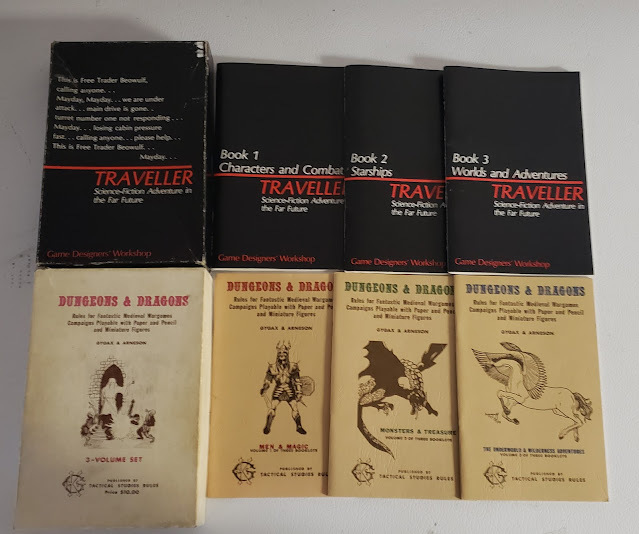
As I move through the editions and versions I'll also talk about all the other materials that have been used with Traveller (board games for example) and how these "3LBBs" expanded to cover an entire universe.
13 comments:
There are differences between the 77 printing and the 81 printing...some that addresses skills and combat are the ones that I seem to remember the most. I started with 77 myself and then 81 but I remember the one item was the 1983 Deluxe set...I remember it because I biked from my house to the hobby store in Yorktown mall and on the way back had a flat tire and walked the bike the rest of the way. All that way I was just dying to open that box... Traveller was my first Sci-fi game, I went from DnD to Top Secret and then Traveller... Looking forward to more posts, Thanks Tim!!
It was definitely my second RPG after D&D, although I'm hazy on my third. Champions or Villains & Vigilantes, most likely. Maybe Empire of the Petal Throne, although I'm regretting that one these days.
To me, I look at "modern" D&D (3e+), and I see more Traveller than AD&D. Where Gygax had a different mechanic for everything, Traveller had one. Tunnels and Trolls did something like it first, but it's a bit messy compared to Miller's. As for the computer thing, I think ths SF convention of writing what the audience would recognize, over the reality applied here. The computer systems of the day were more advanced than those in the book, but the book more resembled the popular media view of computers. V For Vendetta, written at about the same time, treated The Computer (singular) much the same way. Traveller was, and still is, one of the best RPGs for solitaire play. As you say, creating in the game is fun. You can generate a crew, put them on a ship, and roll up a sector full of world's to explore and trade with. All by yourself.
My first sci-fi game. Went out and bought it after a friend introduced me. He based his campaign on Star Wars, and had a crush on Ellen Ripley from Alien. Shinier things like Star Frontiers and Cyberpunk pulled me away for a while, but I found a fan made Star Trek Traveller mod. Now I'm hoping to get a game running again.
Is every roll in Traveller Basic 2d6 roll over? In the PDF of the original LBBs I got from a Bundle of Holding a few years back, some skills had you roll under a target number. I wonder if that's something they cleaned up between versions.
About the computers, I figure ship space is abstractions. A starship computer is running mission critical software, and it takes combat to make it not work. It's not a nice little personal handheld device, it's big iron, more like a flying data center. As for the task system, there wasn't a unified one in CT. That had to wait for MegaTraveller. Most people adapted the combat rules, roll over 8. Although with T5, Marc went to a totally different system.
There are a couple of reasons for the prominence of bladed weapons in Traveller . Most important is that in a lot of adventure science fiction of the time, and notably in the Dumarest books by E.C. Tubb that were so influential on Traveller , bladed weapons are pretty common. The Blade of Traveller is directly from that series, for example (as are the Air/Raft, Low Passage Berth*, Fast Drug, and other elements, but that's not really important to this point). In the "space marines vs. space pirates" type of stories that were pretty common through the 1950s, cutlasses and ray guns were used with equal abandon. You can see this in the game where Marines are given Cutlass skill—and a close look at the combat rules will let you see that in the game a cutlass is a reasonable weapon even against someone wearing Battle Dress/Combat Armor. That would remain true in MegaTraveller , but editions from Traveller: The New Era on treat melee weapons as much less useful on a "modern" battlefield. *In fact, the high fatality rate of Low Passage in the 1977 rules mirrors the Tubb books' descriptions almost exactly.
Kevin S.: No. What you have in those PDFs is how the game was originally designed, and there was not a systematic approach. Rolls were really whatever the Referee or designers thought looked good at the time. Things were not systematized (officially) until MegaTraveller and the Task System, or unofficially by various writers implementing similar ideas (in fact, the Task System was simply the house rules set of the Digest Group designers, which they also presented in their publications for Traveller prior to being given the privilege of writing the official update for the game after doing such a good job on Traveller Book 8 Robots ).
One element you seem to have overlooked (but it is another of the main themes in Traveller, even if the Imperium was detailed only in later publications) is that there is FTL *travel* but no FTL *direct communication*. This influences a lot of the assumptions of the game (which is basically "age of sail"... in SPACE!!!). This shaped the whole game universe in a deep way, and made it difficult to convert adventures from Space Opera, Star Wars, Space Law etc: if you want to inform the HQ of an imminent Zhodani attack... you are forced to jump on a ship and travel all the way to wherever the HQ is. Minimum travel time: 1 week. Exactly like during Napoleonic Wars.
Just a historical note, Marc Miller wrote Classic Traveller while at GDW and has more or less been involved in version since. When GDW folded the copyright for Traveller returned to Marc. Since Marc established Far Future Enterprises he didn't need to purchase the rights to Classic Traveller, he already owned them. The others I'm not so sure about, would have to check if Marc is the original author. I know FFE has purchased some of their titles from the original authors.
This made more sense after I looked up the meaning of RPG lol! It's a generational thing - and none of my grandsons were into RPGs. You live and learn...
Michael Thompson: Marc first implemented the current multidice, roll-under system in T4, but streamlined it somewhat in T5 (mostly by removing half-dice from the equation).
The 1977 rules are also free of the 3rd Imperium that started creeping into the game as its official setting as early as 1980. In 1977 it was assumed you'd create a setting inspired by your favorite sci fi books. And all of this was done pre-Star Wars so the presence of blades has nothing to do with that and a lot to do with the Dumarest knife fights, John Grimes having a blade as part of his service accoutrements, Dune (as mentioned), and of course ERB's Mars and other stories.
Post a Comment
- New profile posts
- Latest activity
Follow along with the video below to see how to install our site as a web app on your home screen.
Note: This feature may not be available in some browsers.
⚖️ Review RPG Review: Traveller5 (Fifth Edition) 3-Book Slipcase Set (2019)
- Thread starter RPGnet News
- Start date Jan 19, 2024

RPGnet Reviews
Reviews are deep dives into games and other media, taking a more holistic approach than the step-by-step of a Let's Read.
Currently, the Review prefix can only be applied by mods. If you'd like us to add it to a thread, just send us the original post via a report and we'll look at adding it.
RPGnet News
- Jan 19, 2024
Capsule Review by Richard Crowley (2/5): Traveller 5.10 is the new revision of the 2013 Kickstarter book and CDROM. This game has been overhauled, organized and rewritten to a point that it contains much of the flavor of the original classic game of 1977. The rulebooks are packed with information, charts and scientific explanations. Traveller5 provides a system that is universal to all previous settings. The product is excellent but quite dense Continue reading...
Users who are viewing this thread
- Welcome to TheRPGSite .

- ► Pen & Paper Roleplaying Central
- ► Reviews
- ► Traveller 5
Traveller 5
Started by jeff37923, July 13, 2013, 10:55:50 PM
- Knight of Common Sense
- Hero Member
- Posts: 18,344

Zachary The First
- Posts: 5,542
Quote from: Zachary The First;670740 Seems like a fair review, Jeff. Thanks for posting it. It sounds like the game wasn't quite ready for primetime, but the Maker systems and tech levels sound neat. How in-depth do they go into the tech levels.
- Toxic SocioCat
- Posts: 14,820
Quote from: Spinachcat;670849 So the Kickstarter patrons paid $75 for a playtest document and after the fan base (what's left of them) does all the playtesting, editing and reworking of the rules, then everyone in the KS is going to get a free copy to replace their "ashcan edition"? Or will they be paying an additional $75?
Quote from: Spinachcat;670849 There isn't any justification for spelling mistakes. There is no real justification for proofreading or editing errors because I am quite sure all these fans who are proofing the game now would have done so quite happily before T5 was sent to the printer. And as for selling an un-playtested game? That's idiotic, but somehow acceptable in RPGland whereas that shit don't fly in other game genres. Shame. The Maker rules sounded interesting.
Quote from: jeff37923;670878 pretty sure that you didn't bother to be a part of the Kickstarter, because you really aren't that interested in Traveller , so you do not have a stake in this.
Quote from: Spinachcat;671126 As one of the only GMs in California who runs Traveller at conventions, as I have for the past 30 years, I suspect I'm plenty interested in Traveller. The lack of Traveller at cons has always surprised me since CT especially is perfect for one shots with new players. But sadly, I don't think there is a handful of active GMs in the state who play Trav outside their house I did not join the KS because I wasted money on T4. That game was a half-assed disappointment (with lots of bright points) and nothing in the T5 KS promo lead me to believe that things were going to be better this time around.
- setting junkie
- Posts: 3,882
Quote from: danbuter;671167 Jeff, you're way too defensive about this.
Quote from: danbuter;671167 It was a great review, though.
Quote from: danbuter;671167 My biggest thing is the makers. Could you post how they work, exactly? Your review is very opaque about them, other than they make stuff.
dungeon crawler
- Full Member
rafaelsmoreno
Quote from: rafaelsmoreno;677518 Well, I am a long time role player, being in the game since 1994 (mostly GURPS, AD&D and Shadowrun). I love sci-fi, cyberpunk, space opera, and I thought getting the new Traveller5 to start with the system a good idea. Apparently, I was wrong. What would be the easiest path to get a campaign on the run? Getting rid of Traveller 5 and jumping in Gurps 3rd edition Traveller? Gurps 4th? I find the scenario amazing, but learning the new system seem to be a cumbersome task for veterans, and I am a newbie on that. Any hints?
Quote from: jeff37923;677991 Sorry, I haven't been paying close attention to this thread so ther was a delay. If you are just getting started there are a few options available. The approaches I recommend the highest are using DriveThruRPG and downloading Starter Traveller ( a free basic version of the original Classic Traveller), on the same website download the free Book 0: An Introduction to Traveller for Mongoose Traveller (a backwards compatable in print version of Traveller currently available). Those two will give you a good overview of the roots of the Traveller system. When you are comfortable with spending money, I would suggest either the Mongoose Traveller Core Rules or the Classic Traveller CD-ROM from Far Future Enterprises. GURPS 3rd Traveller is available primarily as a PDF from SJGs and I consider it to be better than GURPS 4th Traveller which is intimately tied to the Interstellar Wars era of the OTU. These will also cost some money.
David Johansen
- Posts: 6,248
- Help | Terms and Rules | Go Up ▲
- SMF 2.1.4 © 2023 , Simple Machines

IMAGES
VIDEO
COMMENTS
It is very good for a old sci fi game. Like with old D&D dungeon crawl the game was designed around a "traveller game". Basically it is assumed you will traveling from planet to planet try not to go broke. Now it is also has a lot of room to build your own setting. 3.
The strong points: Mongoose's previous version of Traveller brought the game back on the spotlight, and reminded a new generation of gamers what a great RPG it is. Mongoose's second edition capitalises on its strengths, and presents a cleaner, leaner design. As much as the Third Imperium, Traveller's default setting, is mentioned, it gets even ...
A review of the classic space opera science fiction RPG Traveller, covering character generation, skills, combat, equipment, starcraft, and more. The reviewer praises the book's style, content, and ease of play, but criticises the aliens and the psionics system.
The first in a 10-part series where I discuss Mongoose Traveller Second Edition (MGT2). I give my thoughts on the game, and dispel one persistent myth about ...
A review of the new Traveller 2nd Edition core rulebook by Mongoose Publishing, which includes starship generation rules and a modernized layout. The reviewer praises the improvement in quality and customer support, but notes that the book is not for traditional Traveller fans and that the 2300AD products are also worth checking out.
Traveller 2nd Edition was first released in 2016. A revised update was released in 2021 and called the "2022 Edition." Both are the same rules though the 2022 update has a few improvements in layout and editing. For this review I am just going to consider the 2022 version and notes from the 2016 version. Traveller Core Rulebook Update 2022.
Genre: Latest edition of the Traveller roleplaying game corebook. Pages: 264 pages. MSRP: 59.99 in hardcover or 30.00 in PDF at DriveThruRPG. Traveller has existed as a roleplaying game since 1977, but this reviewer has no personal experience with any previous versions in which to compare the 2022 edition. Traveller is a d6 game.
The most recent version of Traveller is available from Mongoose Publishing. It keeps most of what makes the game a classic RPG with a few nods to modern game design. Rather than the risk of dying ...
Feb 19, 2018. #1. Mongoose Traveller Core Rulebook 2nd Edition. TL;DR: The new edition of Mongoose Traveller has vastly improved layout, artwork and coherent streamlined rules that remain compatible with previous editions. The proofreading and quality of the book is a step change from Mongoose's previous output.
Traveller (with 2 L's) is a serious, details-oriented scifi RPG that originated in 1977. It has changed hands multiple times over the years, and Mongoose Pub...
Note: A tabletop RPG (Role Playing Game) is where a GM (Games Master, aka Referee), runs a game, with the key characters (aka the Travellers) being played by the players. Mongoose launched a new era for the Traveller tabletop Role Playing Game (RPG) in 2008, with the first edition of its core rule book (CRB), as a hardy A4-sized hardback book.
Traveller is a science fiction role-playing game first published in 1977 by Game Designers' Workshop. Marc Miller designed Traveller with help from Frank Chadwick, John Harshman, and Loren Wiseman. Editions were published for GURPS, d20, and other role-playing game systems.From its origin and in the currently published systems, the game relied upon six-sided dice for random elements.
Year: 2022. Genre: Classic science fiction roleplaying game. Pages: 264. MSRP: $59.99 for the hardcover or $30.00 for the PDF at DriveThruRPG. In many ways, Traveller is to science fiction roleplaying what Dungeons & Dragons is to fantasy roleplaying. First published in 1977, Traveller has been through many editions and publishers in its long ...
Taking a look at the Starter Set for Mongoose Traveller, a sturdy box that exceeded my expectations.Pick it up at Mongoose here: https://www.mongoosepublishi...
Review of The Traveller's Handbook. Goto [ Index ] For those that aren't aware of it, Traveller was one of the original science fiction role playing games, and indeed, one of the first role playing games, period. It was originally just rules, but a setting was developed over the years, product by product. It's had a long and rather tangled ...
A look at the Traveller adventure Mission to Mithril, by Mongoose Publishing. It offers combat, survival, a mystery, and giant worms, but we do have a couple...
Every Traveller book is now printed in full colour and all core rulebooks and supplements are gorgeous hardbacks, packed with everything you have come to expect from your favourite science-fiction RPG. Traveller contains everything needed to play any science-fiction campaign, from desperate battles across the stars against evil empires, through ...
According to it what I am reviewing today is "Basic Traveller" and published in 1981. Basic Revised was published in 1981 and the Traveller Book (my first purchase) was in 1982. Book 1: Characters and Combat. This is the character generation book and maybe one of the most famous bit of RPG lore ever. Yes.
The previous MGT1 could easily be identifiable with a mid-80s, black and white RPG "document". MGT2 looks modern, with a great layout and adequate art (a challenge for most of the recent Traveller RPGs). The base system for the game is a 2D6 system, with positive and negative modifiers. The target number is 8 by default, but can range from 4 to ...
Capsule Review by Richard Crowley (2/5): Traveller 5.10 is the new revision of the 2013 Kickstarter book and CDROM. This game has been overhauled, organized and rewritten to a point that it contains much of the flavor of the original classic game of 1977. The rulebooks are packed with...
This is a review of Traveller5, which was funded through this Traveller5 kickstarter. I participated in this kickstarter and have been involved in the playtest for this RPG, hence my own review may be considered biased by the reader. Traveller5 is not the RPG that it could have been. Actually, Traveller5 is not the RPG it should be, yet.
Advice I read there over a decade ago still comes in useful. This is a magnificent little volume. Book 1: Characters and Combat provides a character creation system, task resolution rules and the all-important combat system. Character creation in Traveller is bonkers. Truly unique. One-of-a-kind.